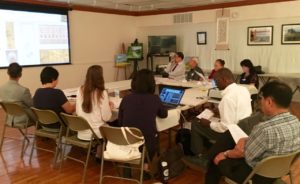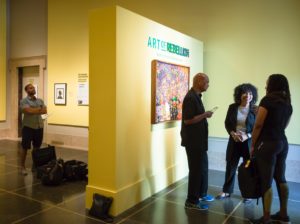Polyvocality and Representation: What We Need Now
“REPRESENT.”
It was an unhesitating one-word answer given during an in-community consultation. This past week, we conducted this consultation at the regional Korean-American Community Center to solicit feedback on the early concepts of an interpretive plan for a new installation of the Korean art collection at the Detroit Institute of Arts. The Korean project is part of a larger reinstallation of our Asian collections to open in Fall of 2018. At the end of the session, the question that was asked and emphatically answered was, “What must the Detroit Institute of Arts remember to do as we reinstall our Korean art collection?”
Represent.
The word—along with many others (reflect us, mirror our realities, tell our stories, etc.)—comes up over and again in the conversations DIA teams have with community members whose identities and heritage infuse and are infused by the art we collect and exhibit.

In this same week, we opened the exhibition Art of Rebellion: Black Art of the Civil Rights Movement, as part of a city-wide reflection on the 50-year anniversary of the 1967 uprising in Detroit. For this exhibition the curatorial-interpretive team partnered with colleagues at our neighboring institution the Charles H. Wright Museum of African and African-American History as they developed their own art exhibition, Say it Loud: Art, History, Rebellion. We co-developed the exhibitions and brought in focus groups of African Americans from various generations as well as advisory panels to critique, challenge, and respond to the exhibitions during the interpretive planning process. Their input influenced wide-ranging aspects of the resulting DIA show—from artworks added to include Detroit artists and adapted themes to the inclusion of perspectives from spoken word poets, a psychologist, historians and writers. Most call Detroit their home or lived through the unrest 50 years ago. For these advisors, and so many of our visitors, the issues and images presented in this exhibition represent their city’s racial, social, political, and economic realities but also their own personal and communal identities and memories.
The DIA’s Asian reinstallation project and the Art of Rebellion exhibition offer two examples of various ways the principle of polyvocality can be applied. It is a principle I mention briefly in “Inclusion Requires Fracturing” published in the spring 2017 issue of the Journal for Museum Education dedicated to the topic of racism and transformational practice in museums. In the article, I describe polyvocality as “the integration of many voices and streams of discourse” and a powerful tool to fracture the traditional, univocal Westernist authority of museums (Anila 2017). It’s an especially critical approach when seeking to identify and dismantle museum knowledges constructed in and inflected by colonizing practices and racial and cultural privilege. In the art museum context in which I operate, the challenge remains: if we seek to understand more deeply, humanize, and appreciate people whose identities and ways of being have been silenced, marginalized, or otherwise made invisible, we have to pursue ways to add and multiply meaning to be inclusive. On reflection, the idea of polyvocality, which may read as the same as multiple perspectives, deserves a bit more exploration. Here, I would stretch the notion of polyvocality to include
- individual perspectives—this aspect of polyvocal inclusion honors individuality and heterogeneity by underscoring the validity of the ideas and perspectives persons generate based on their personal experiences, memories, ideas, and lived experiences.
- ways of knowing—here polyvocality accesses collective knowledge bases. These streams of discourse can refer to disciplinary expertise (scientific, literary, historical, etc.). Included here are those discursive knowledge systems generated within heritage communities (racial, ethnic, religious, etc.) and within diverse sites of cultural expression.
- temporality—polyvocal practice observes temporal perspectives—that is, the acknowledgement that perspectives and perceived “truths” change over time. Scientific communities, for example, depend heavily on the principle that conclusions and bases for knowledge adapt or change based on new research and discoveries. In museum contexts, temporality makes space for individuals, cultures, and communities—including scholarly ones—to reconsider their ideas and standards of belief and practices with the passage of time and on reflection.
So how do we pursue polyvocality? What are some paths and opportunities for its application? The DIA and other museums committed to community engagement such as the Oakland Museum of California, Minnesota Historical Society, and many others use various audience engagement methods. Below are a few examples in growing use at the DIA.
Community-inclusive teams
Content development teams of museum curators and interpreters expand to include people of particular communities. While they might be professionals or experts in a range of disciplines, they are essentially non-art experts who bring their life experiences to serve as consultants. They participate as team members, attend regular meetings, and contribute to the making of the visitor experience during major stages of exhibition development.
Advisory panels
Experts in various disciplines or areas related to art and themes of an exhibitions advise the curatorial-interpretive team in one-time meetings at two or more stages of the development process. Museum staff presents the materials they have developed for open critique, suggestion, and challenge. The advisors offer questions and new points of insertion into the subject matter based on their scholarship and expertise.
Focus groups
Participants are selected based on demographic profiles and identity affinities. They are usually infrequent art museum-goers called in for a single three-hour meeting to learn about exhibition concepts, art objects and main themes so the staff team may glean points of resonance and dissonance. Unlike market research focus groups where staff members sit behind one-way glass, project content focus groups are facilitated by evaluation staff and conducted with staff teams on the perimeter of the room. This creates a different kind of personal accountability of staff to focus group participants.
In-community consultations
For these consultations, exhibition teams connect with one person at a community organization or with networks with people of identity affinities related to or affected by exhibition content. That person—not the museum—selects participants for the consultation. In addition, in-community consultations must happen, to the degree possible, away from the museum and in the community—whether at a cultural center, at a person’s home, in a rented space or elsewhere. The premise is to remove the safety nets of vetting we employ and put more control in the hands of community members. They choose their participants. We meet in their places of comfort, not ours. We present the exhibition concepts and plans and open to conversation and questions. The goal is to promote honest, critical, unapologetic feedback from participants and to deliberately place ourselves as museums in non-dominant positions of listening, learning, and humility.
Not all DIA projects are assigned these audience engagement methods. Some have none at all. Depending on a project’s longevity, potential for community relevance and engagement, as well as cultural sensitivities, DIA teams might use one or more engagement methods. For the DIA’s Asian reinstallation project, all four methods have been integrated as required aspects of the development process.

These engagements can be expensive for museums in terms of monetary costs and staff resources. It takes longer to work this way and requires tools, time, and creativity to process what is learned and transform it into learning opportunities for visitors in exhibitions. Inclusive practice on projects is hard for museums. But it has been harder for much longer and in more ways for people whose identities and experiences have been marginalized in museum representation. Arguably the costs not to care for their needs are more wide-reaching across a collective cultural consciousness than the small investments we make now.
But what are other ways to achieve polyvocality? How else can we infuse our work with voices, ideas, and the imaginings of the people we should serve? PhD candidate and museum practitioner and critic, Porchia Moore argues, “Diversity can’t exist to provide a diverse experience for a dominant culture. True diversity means that representativeness is experienced by everyone. How can we create this atmosphere?” Further she challenges, “Let’s stop writing diversity initiatives and implement new models of inclusion. We should be cultivating relationships….We should literally put on our sneakers and walk our neighborhoods and introduce ourselves in new ways” (Moore 2015).
Likewise, in his talk as one of AAM 2017’s featured speakers, Bryan Stevenson, public interest lawyer and founder of the Equal Justice Initiative, argued for proximity–“We cannot be effective in addressing the issues we are trying to change without getting close to the parts of our community that are…struggling. There’s something with art and culture that we can do to embrace the neglected and traumatized” (Stevenson 2017).
As I consider these thinkers’ challenges, I imagine “what ifs?” With the tools we now have to work remotely, in the cloud, through Skype, and by other means, what might a project become if a small museum team worked in offices offsite, within communities—within community centers. I wonder what new connections, languages, and stories would emerge to enrich all visitors’ experiences in museums if teams embedded for some time with partners in cultural communities and in their spaces?
I wonder what other ideas there are for creative engagements. How are museums connecting in deep ways with audiences not just for interpretation but in other areas of education work? I look forward to the possibilities in shared practices to demand more of ourselves and our institutions in this hard and necessary work—to represent.
Swarupa Anila is director of interpretive engagement at the Detroit Institute of Arts. She leads a talented team of interpretive experts in the development of innovative interpretive strategies for visitor-centered exhibitions and permanent collections installations.
Resources and References
Anila, Swarupa. “Inclusion Requires Fracturing.” Journal of Museum Education. Volume 42, issue 2, pp. 108-119.
Moore, Porchia. “Ignite.” Museum Computer Network Annual Conference. Dallas, 2017.
Stevenson, Bryan. “Truth and Reconciliation: Using Cultural Spaces to Change the Narrative.” American Alliance for Museums Annual Conference. St. Louis, May 8, 2017.

